lock NISSAN MAXIMA 2021 Owner´s Manual
[x] Cancel search | Manufacturer: NISSAN, Model Year: 2021, Model line: MAXIMA, Model: NISSAN MAXIMA 2021Pages: 476, PDF Size: 3.32 MB
Page 11 of 476

1. Engine hood (P. 3-20)
2. Wiper and washer switch (P. 2-42)
3. Windshield (P. 8-17)
4. Power windows (P. 2-65)5. Door locks (P. 3-4)
NISSAN Intelligent Key® (P. 3-7)
Keys (P. 3-2) 6. Mirrors (P. 3-27)
Side view camera (if so equipped)
(P. 4-21)
7. Tire pressure (P. 8-26) Flat tire (P. 6-3)
Tire chains (P. 8-34)
8. Headlight and turn signal switch
(P. 2-45)
LED Daytime Running Lights (DRL)
system (P. 2-45)
Replacing bulbs (P. 8-23)
9. Fog light switch (if so equipped) (P. 2-45)
10. Front sonar sensors (if so equipped)
(P. 5-116)
11. Front view camera (if so equipped)
(P. 4-21)
Refer to the page number indicated in
parentheses for operating details.
LIC4612
EXTERIOR FRONT
Illustrated table of contents0-3
Page 12 of 476

1. Rear window defroster switch (P. 2-45)
2. Interior trunk lid release (P. 3-21)
3. High-mounted stop light (P. 8-23)4. Exterior trunk lid release/request but-
ton (P. 3-16)
Rearview camera (P. 4-3, 4-21)
Trunk lid (P. 3-21) 5. Rear sonar sensors (P. 5-116)
6. Replacing bulbs (P. 8-23)
7. Fuel-filler door (P. 3-22)
Fuel recommendation (P. 10-3)
8. Child safety rear door locks (P. 3-4)
Refer to the page number indicated in
parentheses for operating details.
LIC4608
EXTERIOR REAR
0-4Illustrated table of contents
Page 17 of 476
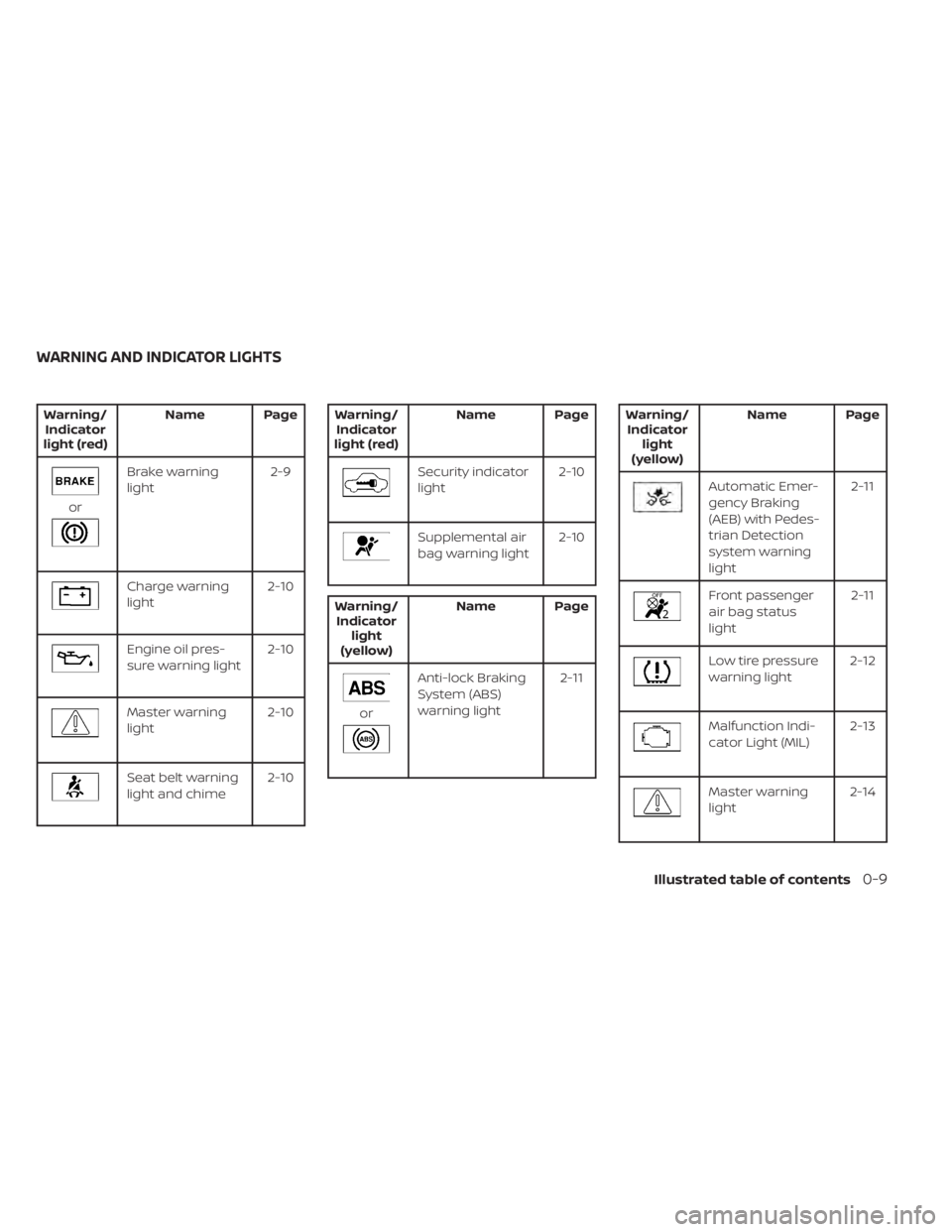
Warning/Indicator
light (red) Name Page
or
Brake warning
light
2-9
Charge warning
light2-10
Engine oil pres-
sure warning light2-10
Master warning
light2-10
Seat belt warning
light and chime2-10
Warning/
Indicator
light (red) Name Page
Security indicator
light
2-10
Supplemental air
bag warning light2-10
Warning/
Indicator light
(yellow) Name Page
or
Anti-lock Braking
System (ABS)
warning light
2-11
Warning/
Indicator light
(yellow) Name Page
Automatic Emer-
gency Braking
(AEB) with Pedes-
trian Detection
system warning
light 2-11
Front passenger
air bag status
light
2-11
Low tire pressure
warning light
2-12
Malfunction Indi-
cator Light (MIL) 2-13
Master warning
light2-14
WARNING AND INDICATOR LIGHTS
Illustrated table of contents0-9
Page 20 of 476
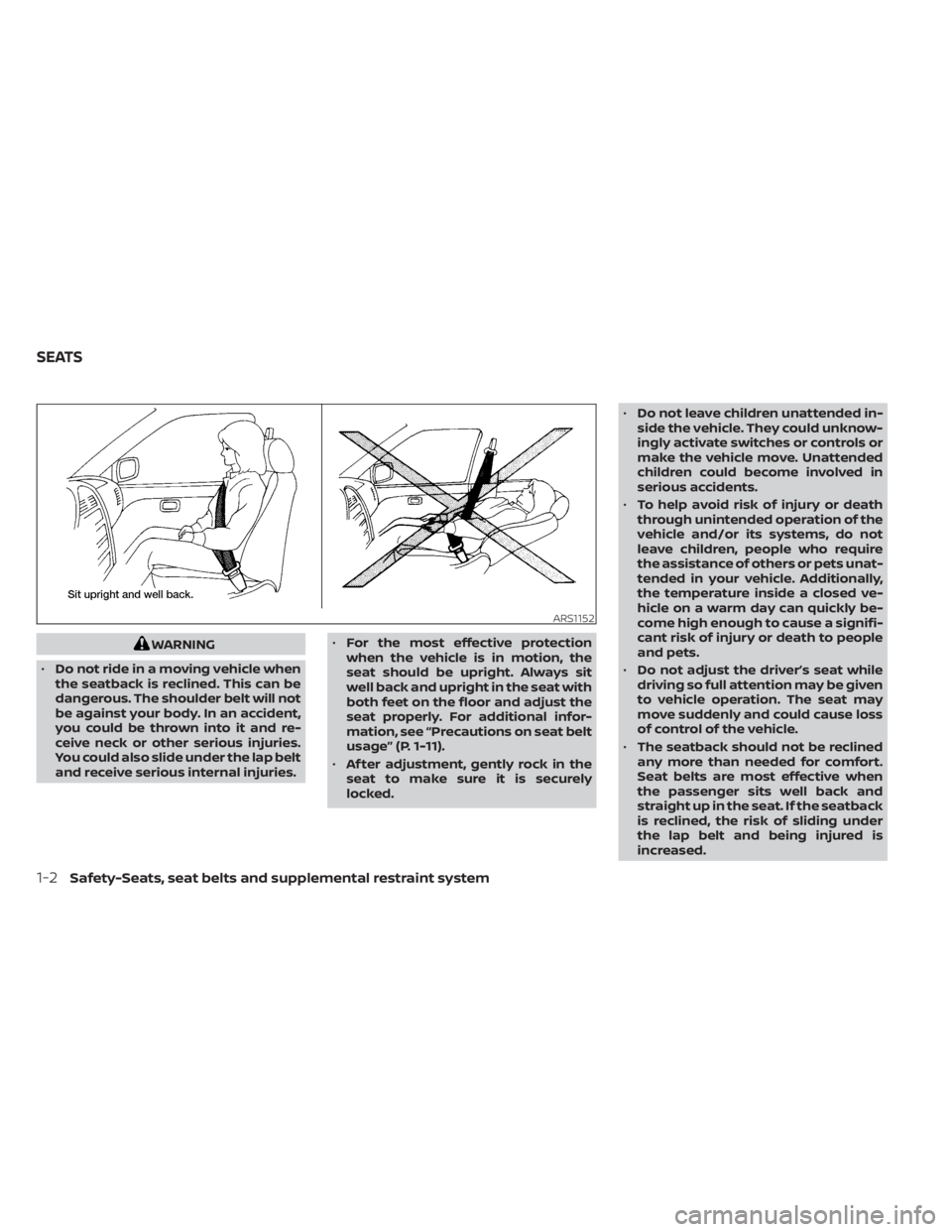
WARNING
• Do not ride in a moving vehicle when
the seatback is reclined. This can be
dangerous. The shoulder belt will not
be against your body. In an accident,
you could be thrown into it and re-
ceive neck or other serious injuries.
You could also slide under the lap belt
and receive serious internal injuries. •
For the most effective protection
when the vehicle is in motion, the
seat should be upright. Always sit
well back and upright in the seat with
both feet on the floor and adjust the
seat properly. For additional infor-
mation, see “Precautions on seat belt
usage” (P. 1-11).
• Af ter adjustment, gently rock in the
seat to make sure it is securely
locked. •
Do not leave children unattended in-
side the vehicle. They could unknow-
ingly activate switches or controls or
make the vehicle move. Unattended
children could become involved in
serious accidents.
• To help avoid risk of injury or death
through unintended operation of the
vehicle and/or its systems, do not
leave children, people who require
the assistance of others or pets unat-
tended in your vehicle. Additionally,
the temperature inside a closed ve-
hicle on a warm day can quickly be-
come high enough to cause a signifi-
cant risk of injury or death to people
and pets.
• Do not adjust the driver’s seat while
driving so full attention may be given
to vehicle operation. The seat may
move suddenly and could cause loss
of control of the vehicle.
• The seatback should not be reclined
any more than needed for comfort.
Seat belts are most effective when
the passenger sits well back and
straight up in the seat. If the seatback
is reclined, the risk of sliding under
the lap belt and being injured is
increased.
ARS1152
SEATS
1-2Safety-Seats, seat belts and supplemental restraint system
Page 21 of 476
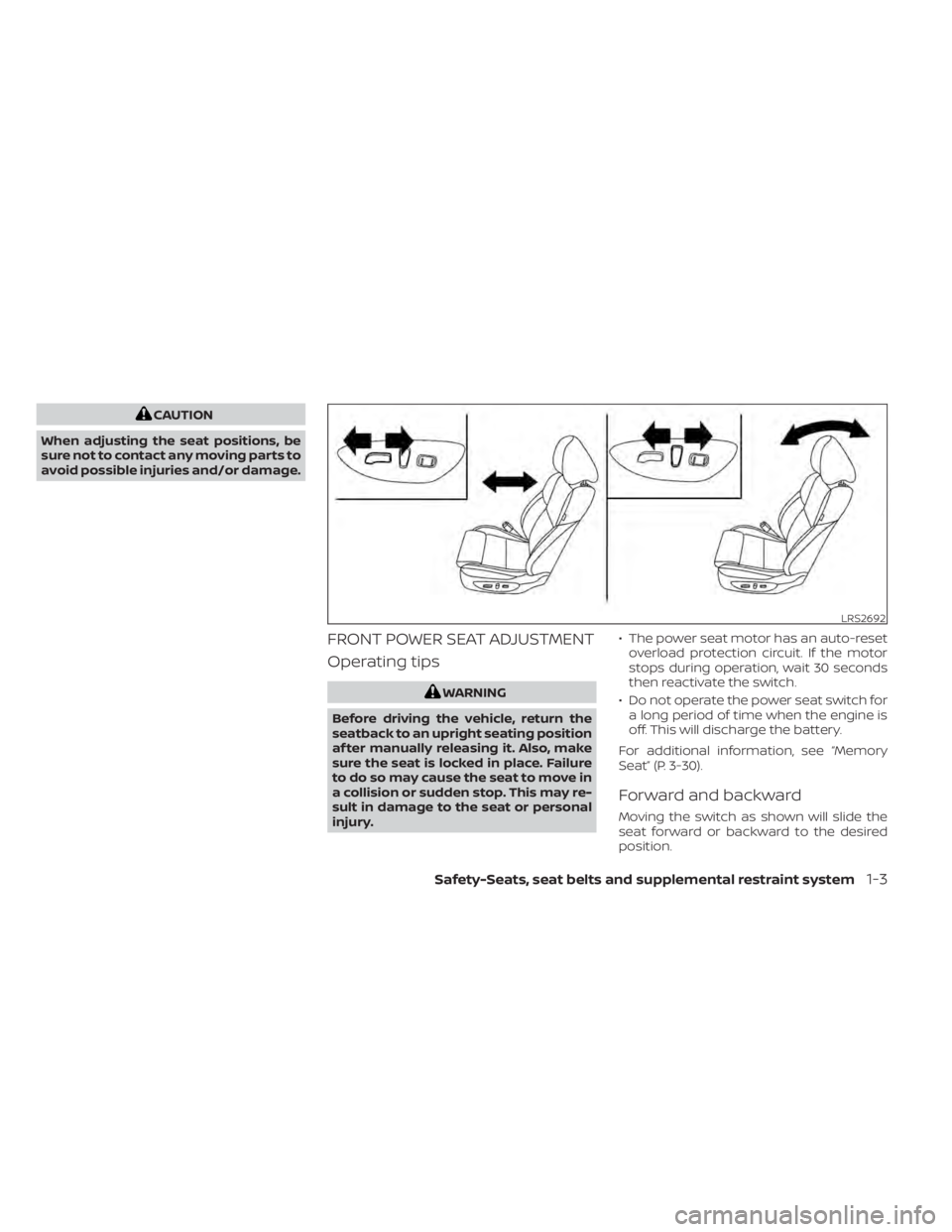
CAUTION
When adjusting the seat positions, be
sure not to contact any moving parts to
avoid possible injuries and/or damage.
FRONT POWER SEAT ADJUSTMENT
Operating tips
WARNING
Before driving the vehicle, return the
seatback to an upright seating position
af ter manually releasing it. Also, make
sure the seat is locked in place. Failure
to do so may cause the seat to move in
a collision or sudden stop. This may re-
sult in damage to the seat or personal
injury. • The power seat motor has an auto-reset
overload protection circuit. If the motor
stops during operation, wait 30 seconds
then reactivate the switch.
• Do not operate the power seat switch for a long period of time when the engine is
off. This will discharge the battery.
For additional information, see “Memory
Seat” (P. 3-30).
Forward and backward
Moving the switch as shown will slide the
seat forward or backward to the desired
position.
LRS2692
Safety-Seats, seat belts and supplemental restraint system1-3
Page 24 of 476
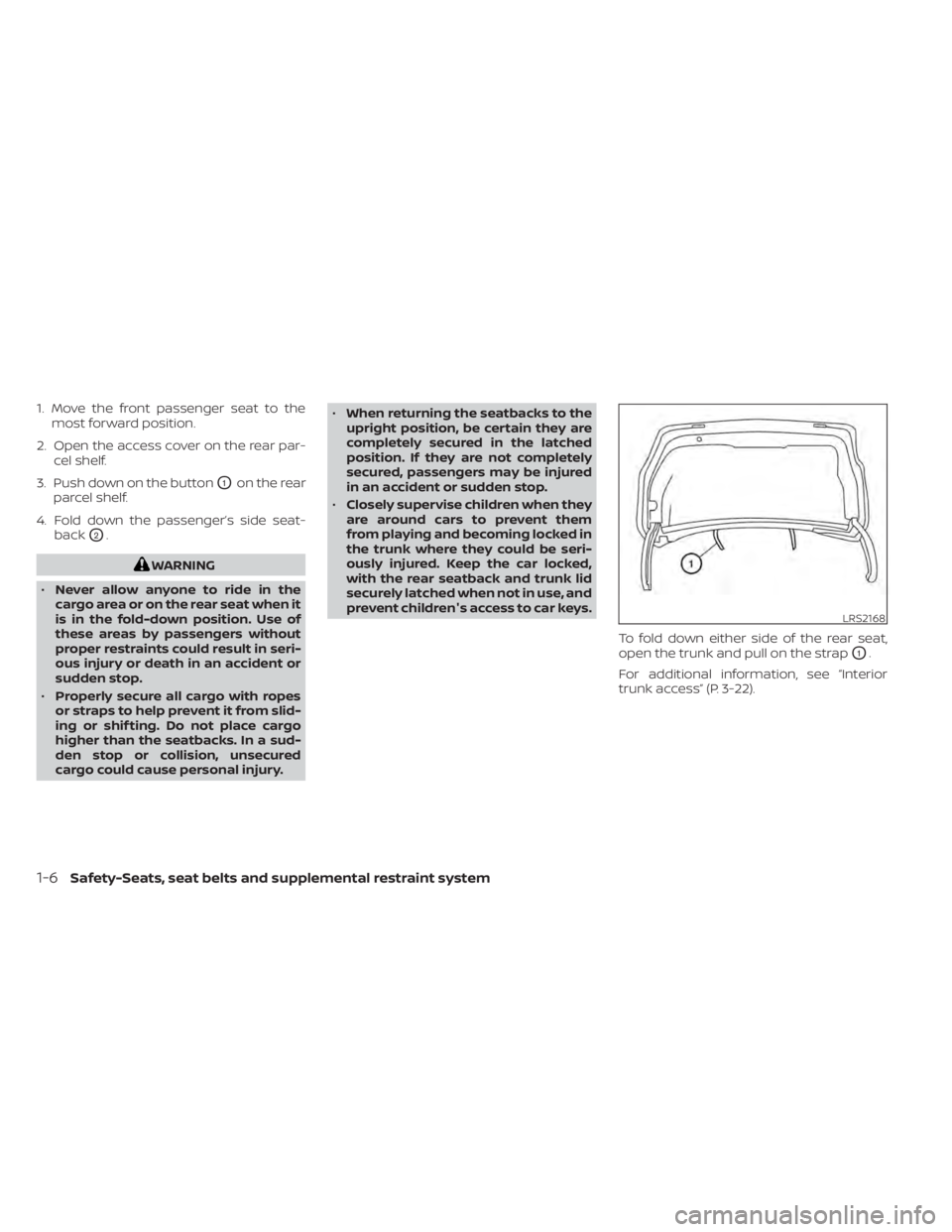
1. Move the front passenger seat to themost forward position.
2. Open the access cover on the rear par- cel shelf.
3. Push down on the button
O1on the rear
parcel shelf.
4. Fold down the passenger’s side seat- back
O2.
WARNING
• Never allow anyone to ride in the
cargo area or on the rear seat when it
is in the fold-down position. Use of
these areas by passengers without
proper restraints could result in seri-
ous injury or death in an accident or
sudden stop.
• Properly secure all cargo with ropes
or straps to help prevent it from slid-
ing or shif ting. Do not place cargo
higher than the seatbacks. In a sud-
den stop or collision, unsecured
cargo could cause personal injury. •
When returning the seatbacks to the
upright position, be certain they are
completely secured in the latched
position. If they are not completely
secured, passengers may be injured
in an accident or sudden stop.
• Closely supervise children when they
are around cars to prevent them
from playing and becoming locked in
the trunk where they could be seri-
ously injured. Keep the car locked,
with the rear seatback and trunk lid
securely latched when not in use, and
prevent children's access to car keys.
To fold down either side of the rear seat,
open the trunk and pull on the strap
O1.
For additional information, see “Interior
trunk access” (P. 3-22).
LRS2168
1-6Safety-Seats, seat belts and supplemental restraint system
Page 26 of 476
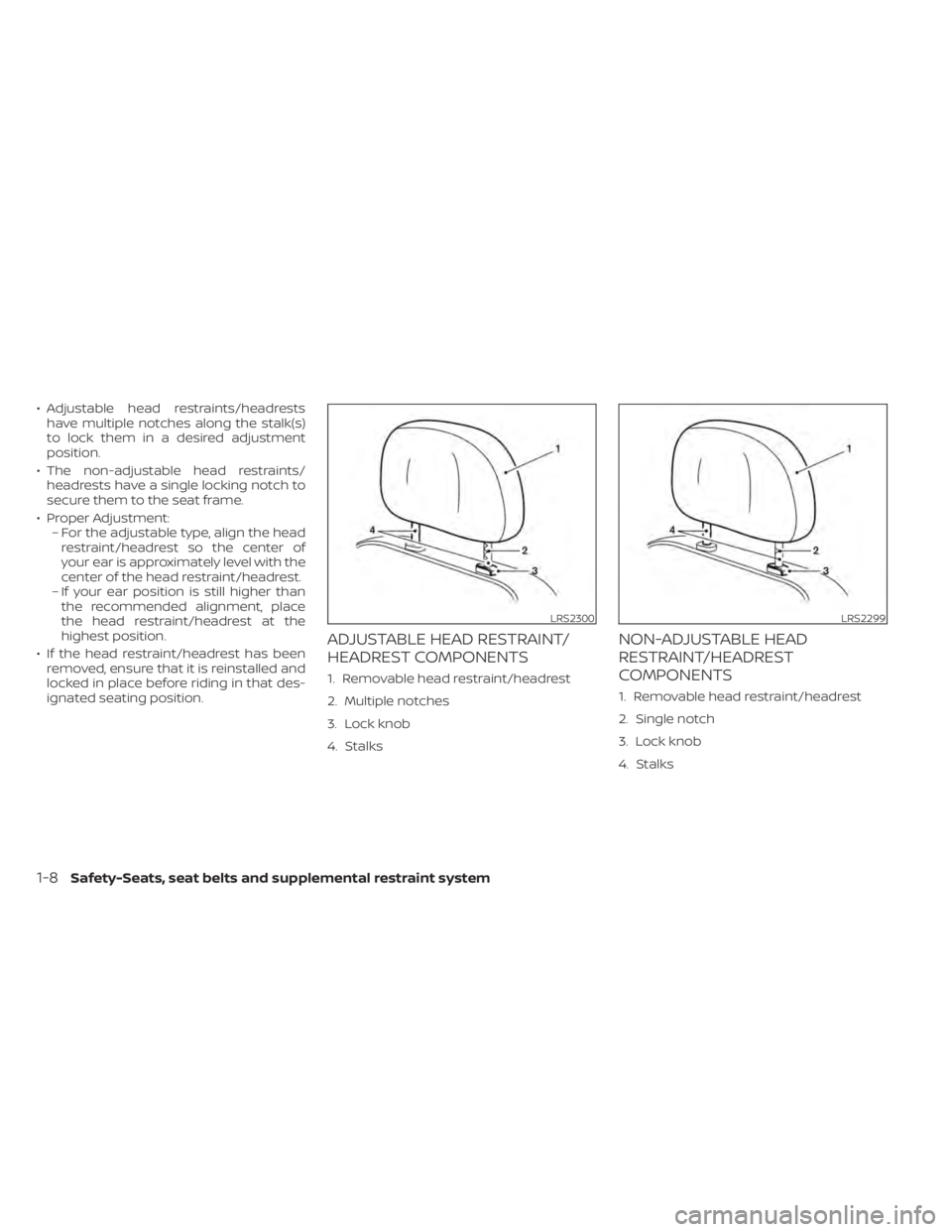
• Adjustable head restraints/headrestshave multiple notches along the stalk(s)
to lock them in a desired adjustment
position.
• The non-adjustable head restraints/ headrests have a single locking notch to
secure them to the seat frame.
• Proper Adjustment: – For the adjustable type, align the headrestraint/headrest so the center of
your ear is approximately level with the
center of the head restraint/headrest.
– If your ear position is still higher than the recommended alignment, place
the head restraint/headrest at the
highest position.
• If the head restraint/headrest has been removed, ensure that it is reinstalled and
locked in place before riding in that des-
ignated seating position.
ADJUSTABLE HEAD RESTRAINT/
HEADREST COMPONENTS
1. Removable head restraint/headrest
2. Multiple notches
3. Lock knob
4. Stalks
NON-ADJUSTABLE HEAD
RESTRAINT/HEADREST
COMPONENTS
1. Removable head restraint/headrest
2. Single notch
3. Lock knob
4. Stalks
LRS2300LRS2299
1-8Safety-Seats, seat belts and supplemental restraint system
Page 27 of 476
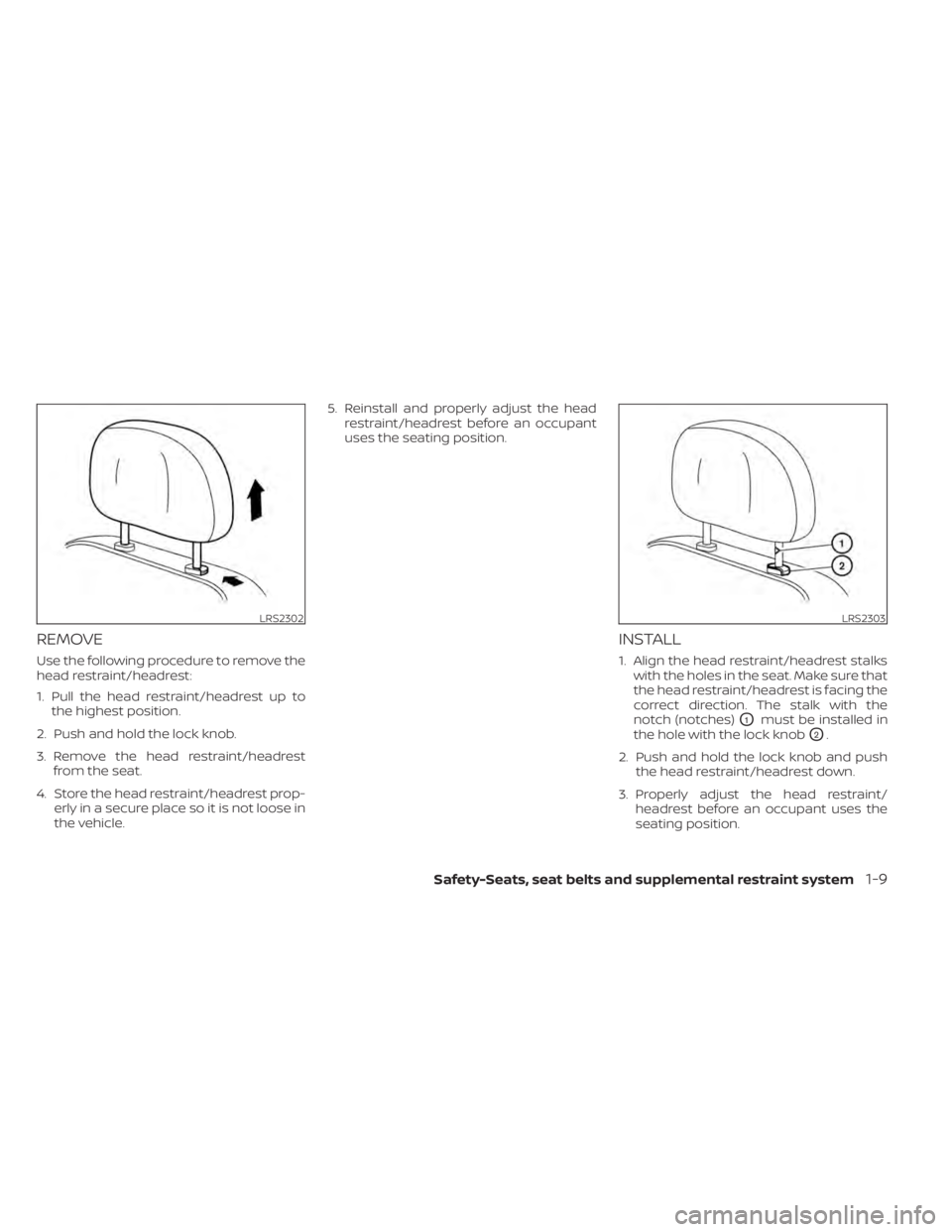
REMOVE
Use the following procedure to remove the
head restraint/headrest:
1. Pull the head restraint/headrest up tothe highest position.
2. Push and hold the lock knob.
3. Remove the head restraint/headrest from the seat.
4. Store the head restraint/headrest prop- erly in a secure place so it is not loose in
the vehicle. 5. Reinstall and properly adjust the head
restraint/headrest before an occupant
uses the seating position.
INSTALL
1. Align the head restraint/headrest stalkswith the holes in the seat. Make sure that
the head restraint/headrest is facing the
correct direction. The stalk with the
notch (notches)
O1must be installed in
the hole with the lock knob
O2.
2. Push and hold the lock knob and push the head restraint/headrest down.
3. Properly adjust the head restraint/ headrest before an occupant uses the
seating position.
LRS2302LRS2303
Safety-Seats, seat belts and supplemental restraint system1-9
Page 28 of 476

ADJUST
For adjustable head restraint/headrest
Adjust the head restraint/headrest so the
center is level with the center of your ears. If
your ear position is still higher than the
recommended alignment, place the head
restraint/headrest at the highest position.
For non-adjustable head restraint/headrest
Make sure the head restraint/headrest is
positioned so the lock knob is engaged in
the notch before riding in that designated
seating position.
Raise
To raise the head restraint/headrest, pull it
up.
Make sure the head restraint/headrest is
positioned so the lock knob is engaged in
the notch before riding in that designated
seating position.
WRS0134LRS2351LRS2305
1-10Safety-Seats, seat belts and supplemental restraint system
Page 29 of 476
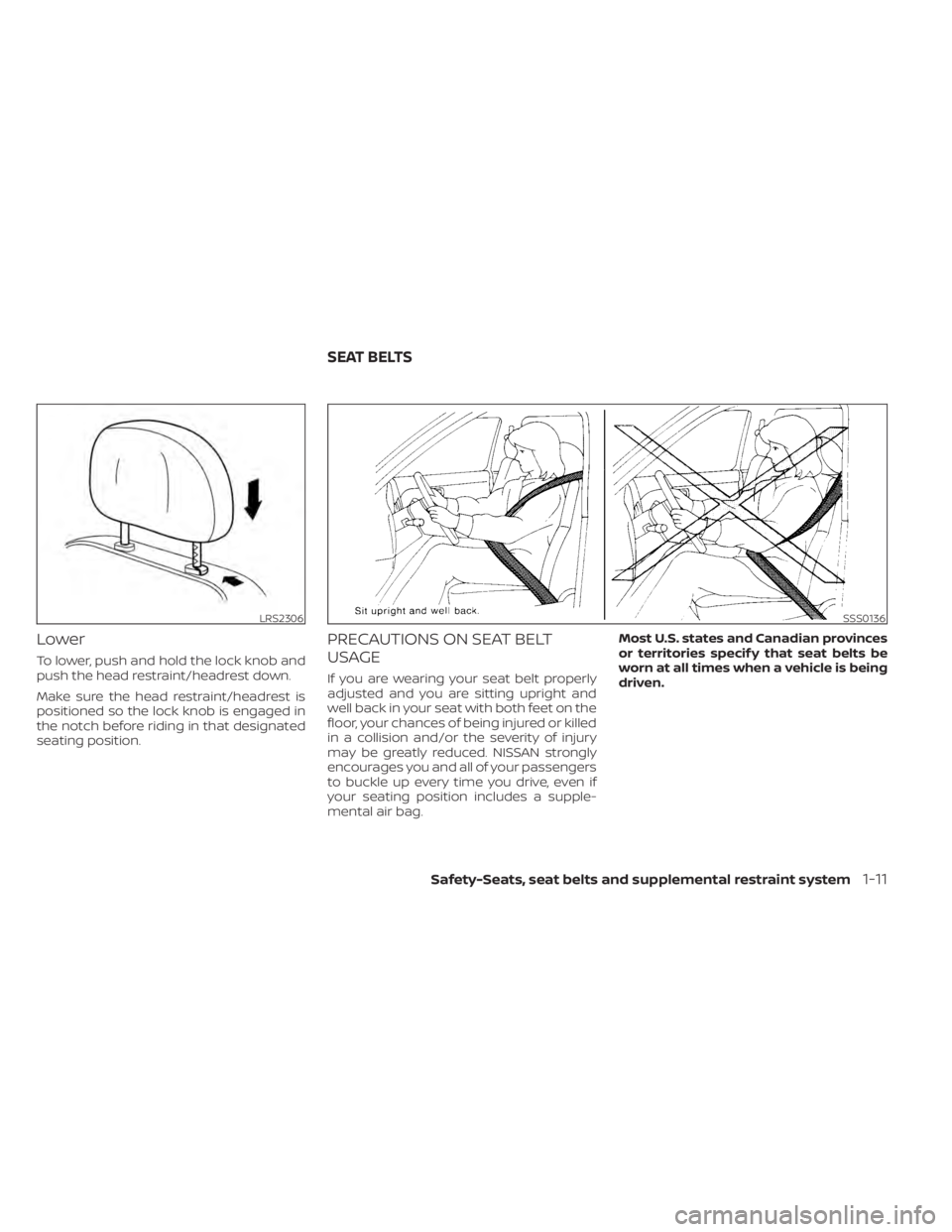
Lower
To lower, push and hold the lock knob and
push the head restraint/headrest down.
Make sure the head restraint/headrest is
positioned so the lock knob is engaged in
the notch before riding in that designated
seating position.
PRECAUTIONS ON SEAT BELT
USAGE
If you are wearing your seat belt properly
adjusted and you are sitting upright and
well back in your seat with both feet on the
floor, your chances of being injured or killed
in a collision and/or the severity of injury
may be greatly reduced. NISSAN strongly
encourages you and all of your passengers
to buckle up every time you drive, even if
your seating position includes a supple-
mental air bag.Most U.S. states and Canadian provinces
or territories specif y that seat belts be
worn at all times when a vehicle is being
driven.
LRS2306SSS0136
SEAT BELTS
Safety-Seats, seat belts and supplemental restraint system1-11